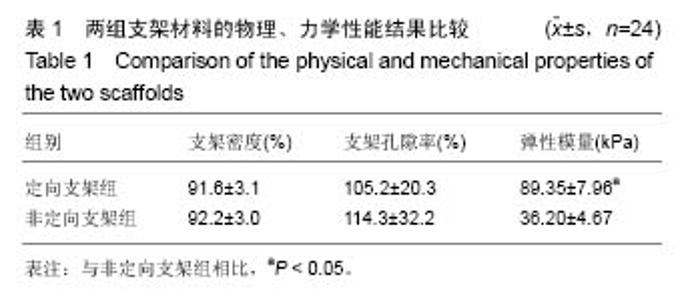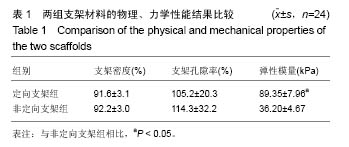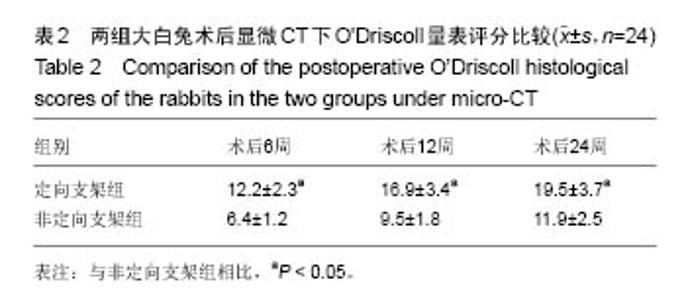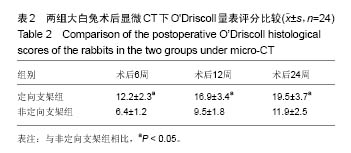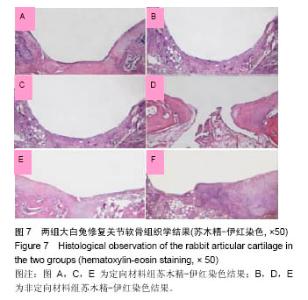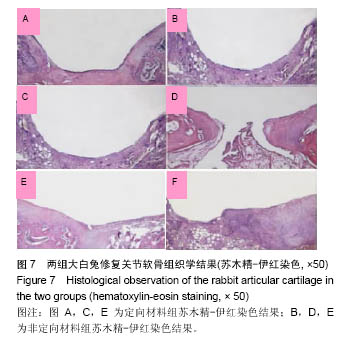Chinese Journal of Tissue Engineering Research ›› 2017, Vol. 21 ›› Issue (2): 209-214.doi: 10.3969/j.issn.2095-4344.2017.02.009
Previous Articles Next Articles
Directional cartilage scaffold for the repair of articular cartilage injury caused by exercise
- 1School of Sport of Jinzhong University, Jinzhong 030619, Shanxi Province, China; 2Department of Physical Education, Shanxi Medical University, Taiyuan 030001, Shanxi Province, China
-
Received:2016-12-13Online:2017-01-18Published:2017-02-27 -
About author:Zhao Xia, M.D., Lecturer, School of Sport of Jinzhong University, Jinzhong 030619, Shanxi Province, China -
Supported by:the Natural Science Foundation of Shanxi Province, No. 2014010023
CLC Number:
Cite this article
Zhao Xia1, Guo Qiu-lin2. Directional cartilage scaffold for the repair of articular cartilage injury caused by exercise[J]. Chinese Journal of Tissue Engineering Research, 2017, 21(2): 209-214.
share this article
| [1]Vo N,Niedernhofer LJ,Nasto LA,et al.An overview of underlying causes and animal models for the study of age-related degenerative disorders of the spine and synovial joints.J Orthop Res.2013;31(6):831-837. [2]Capeci CM,Turchiano M,Strauss EJ,et al.Osteochondral allografts: applications in treating articular cartilage defects in the knee. Bull Hosp Jt Dis.2013;71(1):60-67. [3]张永涛,金丹.组织工程骨软骨复合体构建的研究进展[J].中国修复重建外科杂志,2011,25(9):1120-1124. [4]Lim HC,Bae JH,Song SH,et al.Current treatments of isolated articular cartilage lesions of the knee achieve similar outcomes. Clin Orthop Relat Res. 2012;470(8): 2261-2267. [5]Kelly TA,Roach BL,Weidner ZD,et al.Tissue-engineered articular cartilage exhibits tension-compression nonlinearity reminiscent of the native cartilage.J Biomech. 2013;46(11): 1784-1791. [6]Gardner OF,Archer CW,Alini M,et al.Chondrogenesis of mesenchymal stem cells for cartilage tissue engineering. Histol Histopathol. 2013;28(1):23-42. [7]Schwarz S,Koerber L,Elsaesser AF,et al.Decellularized cartilage matrix as a novel biomatrix for cartilage tissue- engineering applications. Tissue Eng Part A. 2012; 18(21-22):2195-2209. [8]Cheng H,Byrska-Bishop M,Zhang CT,et al.Stem cell membrane engineering for cell rolling using peptide conjugation and tuning of cell-selectin interaction kinetics. Biomaterials. 2012;33(20):5004-5012. [9]刘清宇,王富友,杨柳.关节软骨组织工程支架的研究进展[J].中国修复重建外科杂志, 2012, 26(10):1247-1250. [10]李元城,张卫国,秦建华,等.微流控芯片上胰岛素样生长因子1和碱性成纤维细胞生长因子对兔关节软骨细胞增殖的影响[J].解放军医学杂志, 2013, 38(6):476-480. [11]Fortier LA, Barker JU, Strauss EJ, et al. The role of growth factors in cartilage repair. Clin Orthop Relat Res. 2011; 469 (10):2706-2710.[12]Kwon DR, Park GY, Lee SU. The effects of intra-articular platelet-rich plasma injection according to the severity of collagenase-induced knee osteoarthritis in a rabbit model. Ann Rehabil Med. 2012;36(4):458-465.[13]Lee HR, Park KM, Joung YK, et al. Platelet-rich plasma loaded hydrogel scaffold enhances chondrogenic differentiation and maturation with up-regulation of CB1 and CB2. J Control Release. 2012;159(3):332-337.[14]Kon E, Buda R, Filardo G, et ai. Platelet-rich plasma: intra-articular knee injections produced favorable results on degenerative cartilage lesions. Knee Surg Sports Traumatol Arthrosc. 2010;518(4):472-479.[15]Gobbi A, Karnatzikos G, Mahajan V, et al. Platelet-rich plasma treatment in symptomatic patients with knee osteoarthritis: preliminary results in a group of active patients. Sports Health. 2012;4(2): 162-172.[16]Filardo G, Kon E, Buda R, et al. Platelet-rich plasma intra-articular knee injections for the treatment of degenerative cartilage lesions and osteoarthritis. Knee Surg Sports Traumatol Arthrosc. 2011;19(4):528-535.[17]Kon E, Mandelbaum B, Buda R, et al. Platelet-rich plasma intra-articular injection versus hyaluronic acid viscosupplementation as treatments for cartilage pathology: from early degeneration to osteoarthritis. Arthroscopy. 2011;27(11): 1490-1501.[18]熊小龙, 伍亮, 相大勇, 等.富血小板血浆对大鼠跟腱断裂早期愈合的影响[J].中国修复重建外科杂志, 2012,26(4):466-471.[19]Milano G, Deriu L, Sanna PE,et al. Repeated platelet concentrate injections enhance reparative response of microfractures in the treatment of chondral defects of the knee: an experimental study in an animal model. Arthroscopys. 2012;28(5):688-701.[20]Seixa CI,Soler C,Carillo JM,et al. Effect of autologous platelet-rich plasma on the repair of full-thickness articular defects in rabbits. Knee Surg Sports Traumatol Arflirosc. 2013;21(8):1730-1736.[21]Zhu Y,Yuan M,Meng HY,et al. Basic science and clinical application of platelet-rich plasma for cartilage defects and osteoarthritis: a review. Osteoarthritis Cartilage. 2013;21(11):1627-1637.[22]Andia I,Maffulli N. Platelet-rich plasma for managing pain and inflammation in osteoarthritis.Nat Rev Rheumatol. 2013;9(12): 721-730.[23]Filardo G,Kon E,Pereira RM,et al. Platelet-rich plasma intra-articular injections for cartilage degeneration and osteoarthritis: single- versus double-spinning approach. Knee Surg Sports Traumatol Arthrosc. 2012;20(10):2082-2091.[24]Abrams GD,Frank RM,Fortier LA,et al. Platelet-rich plasma for articular cartilage repair. Sports Med Arthroscs. 2013; 21(4):213-219.[25]Chang KV,Hung CY,Aliwarga F,et al. Comparative Effectiveness of Platelet-Rich Plasma Injections for Treating Knee Joint Cartilage Degenerative Pathology: A Systematic Review and Meta-Analysis. Arch Phys Med Rehabil. 2014; 95(3):562-575.[26]Dold AP,Zywiel MG,Taylor DW,et al. Platelet-rich plasma in the management of articular cartilage pathology: a systematic review. Clin J Sport Med. 2014;24(1):31-43. |
| [1] | Wang Jianping, Zhang Xiaohui, Yu Jinwei, Wei Shaoliang, Zhang Xinmin, Xu Xingxin, Qu Haijun. Application of knee joint motion analysis in machanism based on three-dimensional image registration and coordinate transformation [J]. Chinese Journal of Tissue Engineering Research, 2022, 26(在线): 1-5. |
| [2] | Tan Xinfang, Guo Yanxing, Qin Xiaofei, Zhang Binqing, Zhao Dongliang, Pan Kunkun, Li Yuzhuo, Chen Haoyu. Effect of uniaxial fatigue exercise on patellofemoral cartilage injury in a rabbit [J]. Chinese Journal of Tissue Engineering Research, 2022, 26(在线): 1-6. |
| [3] | Zhang Yufang, Lü Meng, Mei Zhao. Construction and verification of a full spine biomechanical model of adolescent scoliosis [J]. Chinese Journal of Tissue Engineering Research, 2022, 26(9): 1351-1356. |
| [4] | Bai Zixing, Cao Xuhan, Sun Chengyi, Yang Yanjun, Chen Si, Wen Jianmin, Lin Xinxiao, Sun Weidong. Construction and biomechanical analysis of ankle joint finite element model in gait cycle [J]. Chinese Journal of Tissue Engineering Research, 2022, 26(9): 1362-1366. |
| [5] | Liu Feng, Feng Yi. Finite element analysis of different Kirschner wire tension bands on transverse patella fractures during gait cycle [J]. Chinese Journal of Tissue Engineering Research, 2022, 26(9): 1367-1371. |
| [6] | Yao Xiaoling, Peng Jiancheng, Xu Yuerong, Yang Zhidong, Zhang Shuncong. Variable-angle zero-notch anterior interbody fusion system in the treatment of cervical spondylotic myelopathy: 30-month follow-up [J]. Chinese Journal of Tissue Engineering Research, 2022, 26(9): 1377-1382. |
| [7] | Wu Cong, Jia Quanzhong, Liu Lun. Relationship between transforming growth factor beta1 expression and chondrocyte migration in adult articular cartilage after fragmentation [J]. Chinese Journal of Tissue Engineering Research, 2022, 26(8): 1167-1172. |
| [8] | An Weizheng, He Xiao, Ren Shuai, Liu Jianyu. Potential of muscle-derived stem cells in peripheral nerve regeneration [J]. Chinese Journal of Tissue Engineering Research, 2022, 26(7): 1130-1136. |
| [9] | Zhang Jinglin, Leng Min, Zhu Boheng, Wang Hong. Mechanism and application of stem cell-derived exosomes in promoting diabetic wound healing [J]. Chinese Journal of Tissue Engineering Research, 2022, 26(7): 1113-1118. |
| [10] | Duan Chao, Shang Xiaoqiang, Duan Xianglin, Yang Ping, Tao Shengxiang. Stability of patellar claw versus loop plate combined with patellar claw for the treatment of comminuted fractures of the lower pole of the patella [J]. Chinese Journal of Tissue Engineering Research, 2022, 26(6): 934-937. |
| [11] | Wen Mingtao, Liang Xuezhen, Li Jiacheng, Xu Bo, Li Gang. Mechanical stability of Sanders II type calcaneal fractures fixed by two internal fixation methods [J]. Chinese Journal of Tissue Engineering Research, 2022, 26(6): 838-842. |
| [12] | Huang Hao, Hong Song, Wa Qingde. Finite element analysis of the effect of femoral component rotation on patellofemoral joint contact pressure in total knee arthroplasty [J]. Chinese Journal of Tissue Engineering Research, 2022, 26(6): 848-852. |
| [13] | Zheng Yongze, Zheng Liqin, He Xingpeng, Chen Xinmin, Li Musheng, Li Pengfei, Lin Ziling. Extended finite element modeling analysis of femoral neck fracture based on ABAQUS software [J]. Chinese Journal of Tissue Engineering Research, 2022, 26(6): 853-857. |
| [14] | Liu Yuhang, Zhou Jianqiang, Xu Xuebin, Qu Xingyue, Li Ziyu, Li Kun, Wang Xing, Li Zhijun, Li Xiaohe, Zhang Shaojie. Establishment and validation of finite element model of lower cervical spine in 6-year-old children [J]. Chinese Journal of Tissue Engineering Research, 2022, 26(6): 870-874. |
| [15] | Lin Xuchen, Zhu Hainian, Wang Zengshun, Qi Tengmin, Liu Limin, Suonan Angxiu. Effect of xanthohumol on inflammatory factors and articular cartilage in a mouse mode of osteoarthritis [J]. Chinese Journal of Tissue Engineering Research, 2022, 26(5): 676-681. |
| Viewed | ||||||
|
Full text |
|
|||||
|
Abstract |
|
|||||


